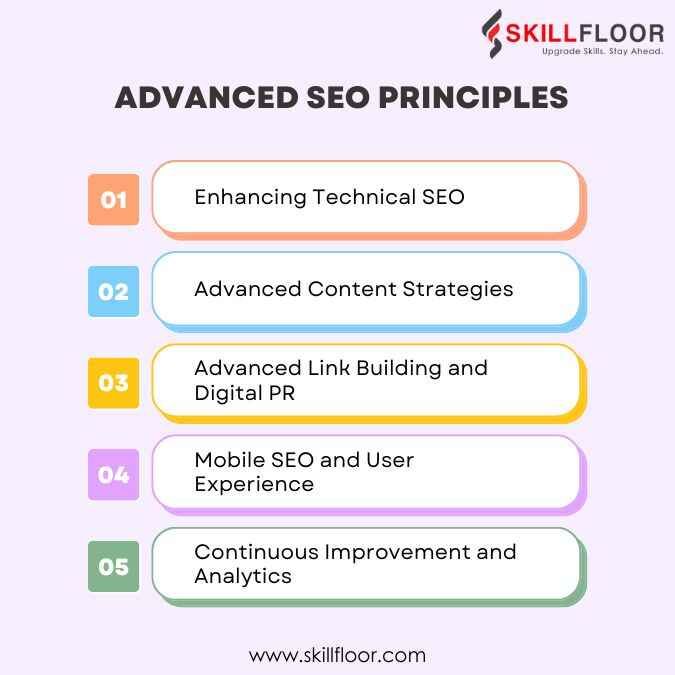Advanced SEO Principles for Boosting Your Website's
Learn effective SEO strategies to improve your website's visibility and attract more visitors organically. Discover expert techniques now

Understanding and implementing SEO Principles is crucial for improving your website's visibility. SEO principles encompass a range of strategies designed to optimize your site for search engines, ensuring that your content ranks higher in search results. Key elements include optimizing on-page factors like meta tags, headers, and keyword usage. By aligning your content with these SEO Principles, you can create a more search-engine-friendly environment that enhances your site's relevance and authority.
Beyond on-page optimization, advanced SEO Principles also involve off-page strategies such as backlink building and leveraging social signals. Building a network of high-quality backlinks from reputable sites can significantly boost your site's credibility and search engine rankings. Additionally, staying updated with the latest search engine algorithms and adapting your strategies accordingly is vital. By integrating these advanced SEO Principles into your digital marketing plan, you can steadily improve your website's visibility, attracting more organic traffic and establishing a stronger online presence.
Enhancing Technical SEO
Ensuring your site is technically sound is foundational to SEO. Going beyond the basics involves a few critical enhancements.
1. Improving Site Architecture
A well-structured website is beneficial for both users and search engines. It helps them navigate your content and understand how different pages are related.
-
Silo Structure: This method organizes content into distinct themes, which helps distribute link authority and establish topical relevance.
-
Breadcrumb Navigation: Adding breadcrumb trails improves navigation and provides additional context for search engines.
2. Using Schema Markup
Schema markup helps search engines understand the details of your content, which can enhance how your site appears in search results.
-
Rich Snippets: Structured data can add extra information to your search listings, like star ratings or event details, making them more appealing.
-
Knowledge Graphs: Feeding data into knowledge graphs can improve your site’s authority and visibility.
3. Optimizing Page Speed
Fast-loading pages are important for both user experience and SEO. Several advanced techniques can help speed up your site.
-
Server Response Time: Lowering the time it takes for your server to respond can significantly boost page load speed.
-
Lazy Loading: This technique loads images and other media only as they come into view, rather than all at once, speeding up initial page loads.
Advanced Content Strategies
Content remains a cornerstone of SEO. Advanced strategies focus on depth, relevance, and engaging your audience effectively.
1. Building Content Clusters
Organizing content around key topics helps establish your site as an authority on those subjects. This involves creating a main page that covers a broad topic and several related pages that dive into subtopics.
-
Interlinking: Linking between the main and related pages strengthens topic relevance and distributes link authority.
-
Content Depth: Thoroughly covering topics within these clusters can help you rank for a variety of related keywords.
2. Leveraging User-Generated Content (UGC)
User-generated content can add credibility and keep your site fresh. Encouraging contributions from your audience can provide valuable, relevant content.
-
Reviews and Testimonials: Encouraging customers to leave feedback can boost your credibility and provide rich content.
-
Community Engagement: Building a community around your brand can foster engagement and generate content that aligns with your audience's interests.
3. Updating and Repurposing Content
Keeping your content fresh and relevant is key. Regularly updating old posts with new information and repurposing content in different formats can broaden its reach.
-
Content Audits: Regularly review your content to find opportunities for updates or improvements.
-
Repurposing: Transforming a blog post into a video, infographic, or podcast can engage different audience segments.
Advanced Link Building and Digital PR
Quality backlinks remain vital for SEO. Advanced link-building goes beyond just outreach.
1. Earning Links Through Content Marketing
Creating valuable, shareable content naturally attracts backlinks. High-quality guides, original research, or interactive tools are more likely to be linked to by others.
-
Resource Pages: Developing useful resources or tools can draw backlinks from other sites.
-
Skyscraper Technique: Find popular content in your niche and create an improved version to attract links from those who linked to the original.
2. Running Digital PR Campaigns
Promoting your brand through online channels can generate backlinks and increase your presence. This includes reaching out to bloggers, journalists, and influencers.
-
Press Releases: Crafting compelling press releases for newsworthy content can attract media coverage and links.
-
Influencer Collaborations: Partnering with influencers in your industry can amplify your content and help secure high-quality backlinks.
3. Broken Link Building
Finding broken links on relevant sites and offering your content as a replacement is an effective way to build links.
-
Finding Opportunities: Use tools to find broken links on other sites and suggest your content as a suitable replacement.
-
Resource Reclamation: Ensuring all links on your site are functional and updating broken ones can also enhance your SEO efforts.
Mobile SEO and User Experience
With more searches happening on mobile devices than on desktops, mobile optimization is essential. Mobile SEO and user experience play significant roles in advanced SEO strategies.
1. Mobile-First Indexing
Google primarily uses the mobile version of your site for indexing and ranking. Ensuring your site is mobile-friendly is critical.
-
Responsive Design: A design that adapts to various screen sizes improves user experience and search performance.
-
Mobile Usability: Easy navigation, readable text, and properly sized touch elements on mobile devices enhance usability.
2. Optimizing Core Web Vitals
Core Web Vitals are a set of metrics that Google uses to evaluate user experience, including loading performance, interactivity, and visual stability.
-
Largest Contentful Paint (LCP): Measures how quickly the main content of a page loads.
-
First Input Delay (FID): Evaluates how quickly a page becomes interactive.
-
Cumulative Layout Shift (CLS): Assesses visual stability by checking for unexpected layout shifts.
3. Voice Search Optimization
With the growing use of voice assistants, optimizing for voice search can increase your site’s visibility for spoken queries.
-
Natural Language Processing: Writing content in a conversational tone that matches how people speak can boost your chances of appearing in voice search results.
-
Featured Snippets: Structuring content to target featured snippets can improve your chances of being selected as a voice search response.
Continuous Improvement and Analytics
Advanced SEO is an ongoing process that involves continuous monitoring and adjustment. Using analytics to track performance and make data-driven decisions is key.
1. Utilizing Advanced Google Analytics
Going beyond basic metrics, advanced analytics track user behavior, conversion paths, and more.
-
Custom Dashboards: Set up custom dashboards to monitor your most important SEO metrics.
-
Goal Tracking: Track conversions and other key actions to measure the impact of your SEO efforts.
2. Experimenting with A/B Testing
Regular testing helps you understand what works best for your audience and your SEO strategy.
-
Content Variations: Test different headlines, calls to action, or formats to see what engages your users most.
-
Technical Experiments: Try different site structures, load times, or mobile layouts to find what improves your SEO performance.
3. Staying Updated with SEO Trends
SEO is always evolving. Keeping up with the latest trends and algorithm updates is vital to maintaining and improving your site’s performance.
-
Industry Blogs and News: Follow reliable SEO blogs and news sources to stay informed about changes in the field.
-
Webmaster Guidelines: Regularly review search engine webmaster guidelines to ensure your site complies with best practices.

What is schema markup, and how does it impact SEO?
Schema markup is HTML code added to a website to provide search engines with additional context about the content. It enhances search engine result listings by highlighting important details like reviews, ratings, events, and FAQs. This structured data helps search engines understand the content better, improving its visibility and relevance in search results. By implementing schema markup, websites can potentially increase click-through rates and attract more targeted traffic, ultimately boosting their SEO performance and online visibility.
By applying these advanced SEO techniques, you can effectively enhance your website’s visibility and performance. Keep refining your approach and staying attuned to the latest developments in SEO to maintain and improve your online presence.




























































